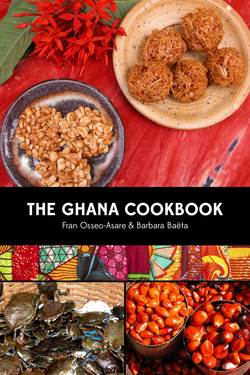Читать книгу The Ghana Cookbook - Fran Osseo-Asare - Страница 11
На сайте Литреса книга снята с продажи.
ОглавлениеTextures, Flavors, & Cooking Methods
Several of the cultural characteristics of Ghanaian cooking listed here are also found in many other parts of Africa as well:
Textures
• There is an emphasis on food texture. Traditionally, food in Ghana is eaten with freshly washed (right) hands. Perhaps because of the intimate, close contact of fingers with food, texture is very important. Generally, pounded food has a very different texture than food that is commercially ground. Some foods are routinely finely ground for many recipes (e.g., sesame seeds, corn, peanuts, onions, wheat flour, cowpeas), while for others a different texture is preferred (e.g., pounding shrimp or tiny dried fish in a wooden mortar or grinding in a ridged clay grinding bowl, tearing rather than liquefying peppers and onions for pepper sauces). At other times, pounding results in a lump-free product, such as when boiled cassava or plantain is pounded to make smooth, elastic fufu. Steamed foods are common and have their distinctive firm textures (e.g., kenkey or dokono, a soured corn and cassava dough steamed in plantain leaves, and tubaani, a steamed black-eyed pea pudding similar to Nigerian moinmoin). Overall, textures range from creamy to crunchy, from firm or smooth and soft to chewy, or lumpy or crispy outside and creamy inside (as in fried ripe plantain). Similarly, finely ground dried corn or finely grated dried cassava yield different products than coarsely ground or grated. One difficulty in substituting blenders for some recipes that are traditionally pounded in a mortar and pestle is that it significantly alters the texture of the foods.
• A preference for “chewiness” of food is also common, whether that be in meat in a stew or on a stick (chichinga), or roasted chicken. My nephews from Ghana still cannot eat fryer chickens from the U.S. because they feel their soft, mushy meat has neither taste nor substance.
• Eating is a quite sensual experience. There is often a love of viscous textures, such as provided by okra or baobab and some leaves like jute (ayoyo). This affinity may be related to the idea that foods are made more palatable by a slippery coating. Oil is especially prized for the way it coats food. Ghana shares this affinity with much of West Africa, and it is indirectly alluded to in Nigerian Chinua Achebe’s famous sentence in Things Fall Apart, “Proverbs are the palm oil with which words are eaten.” In a similar way, fufu (a heavy, elastic dumpling) is coated with soup and swallowed without chewing. The peristaltic movement in the throat is similar to that of swallowing an oyster whole. The texture of the fufu is also in a sense felt and “tasted” with the fingers before it even enters the mouth.
Flavors
• Flavor principles include an affinity for salt, including smoked and salted fish, for spicy flavors (especially from fresh and dried chili peppers and fresh ginger); for bitter and sour flavors, such as is found in some greens and fermented foods; and for what has come to be known as “umami,” found in Ghana’s trademark dried ground shrimp/crayfish, as well as other smoked/dried fish.
• One reason for the popularity of Chinese cooking and soy sauce in Ghana may be the similarity in flavor principles, including the use of ginger and chili peppers, the adoption of seasoning cubes (with MSG), and dried/smoked fish. “Rice and stew” is a classic Ghanaian combination, making it easy to adopt much Asian cooking.
• A flavor that is conspicuously absent in Ghanaian main dish cooking is “sweet.” While sugar or honey may be added to beverages and breakfast porridges and is found in desserts like fools, puddings, cakes, and frozen treats, it is rarely included in main or side dishes, with the exception perhaps of the sweetness imparted by ripe plantains. Even white sweet potatoes, with their lower sugar content, are preferred over the orange ones popular in the United States. Many Ghanaians coming to the United States for the first time find North American food excessively sweet.
Cooking Methods
• While Ghanaians adore Chinese cooking and stir-fries, a major difference is that many dishes in Ghana are time-consuming to prepare and require long, slow cooking times. Cowpeas, free-range meat, and poultry especially tend to need tenderizing by slow simmering. Including a little smoked fish in a bean stew requires time for the flavors to meld after the beans are cooked. Many Ghanaian recipes are slow-cooker friendly and a good fit with the growing “slow foods” movement. However, a few simple tricks can help to greatly reduce the time spent over the stove.
• Busy Ghanaian housewives have always found ways to speed up cooking time. “Gari,” a West African convenience food made from fermented, dried, roasted cassava is a regular kitchen staple. A simple “light soup” (nkrakra or nkrankra) made with fish is also quick to prepare, as are stews made using canned sardines or corned beef.
• In addition to slow simmering on a stove, Ghanaians rely on both shallow-fat and deep-fat frying, generally with a vegetable oil (as in frying ripe plantains for the spicy coated cubes called kelewele, or kose/akara, black-eyed pea fritters, or yam “chips”).
• Steaming, especially in banana or plantain leaves, is popular.
• Grilling, roasting, boiling, and baking all take their place in the repertoire of Ghanaian cooks. Grilling meat, fish, and vegetables in the traditional setting requires a time investment to prepare charcoal or wood fires, but in North America the process of grilling may be greatly simplified.
